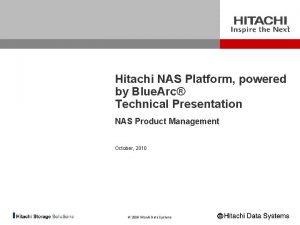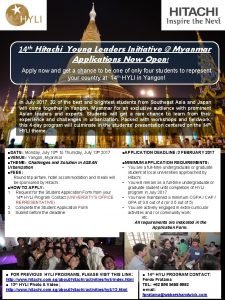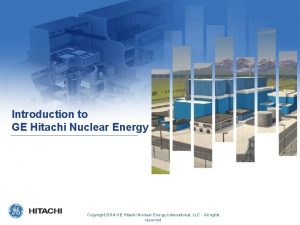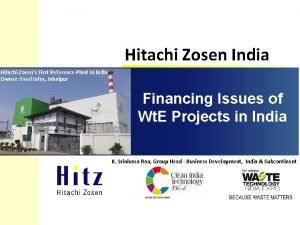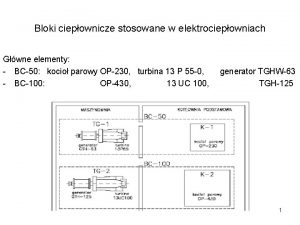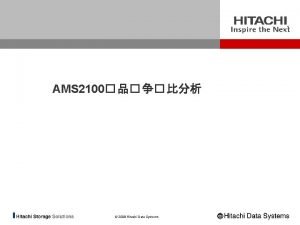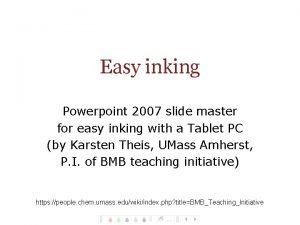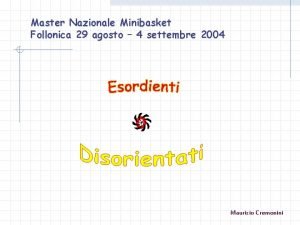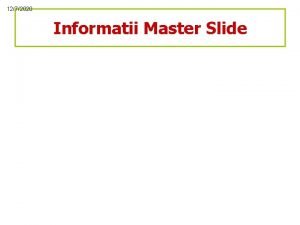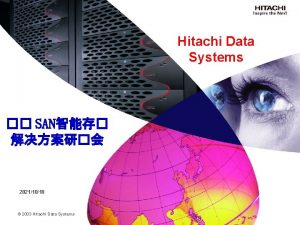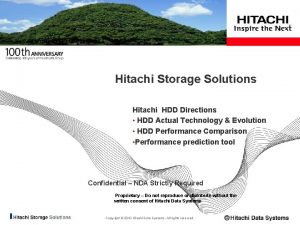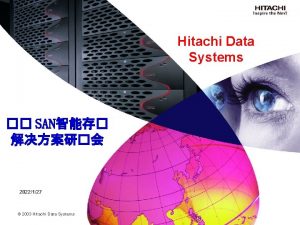Master on Hitachi new slide at end Information

















- Slides: 17

Master on Hitachi new slide at end. Information Systems that Really Support Decisionmaking Gio Wiederhold Stanford University, CSD <gio@cs. stanford. edu>

• information fusion from heterogeneous resources such as databases, text, and semistructured information bases • the decision maker also has to plan and schedule actions beyond the current point-in -time.

–. Quoting from “New World Vistas, Air and Space Power for the 21 st Century”[Mc. Call: 96]: The two ‘Capabilities Requiring Military Investment in Information Technology are: –. Highly robust real-time software modules for data fusion and integration; –. Integration of simulation software into military information systems. ’ • Tools for planning and simulation have benefited from substantial research efforts [Dean. W: 91].

• Simulation tools often deal explicitly with risks and provide measures of certainty as part of their outputs. The simulation results are analyzed by support staff, and summaries are forwarded to the actual decision-maker. It is rare that the decision maker has the time to go back and request analyses of variations of the choices that have been presented.

• To assess the future we must access simulations which employ a variety of technologies [Burnstein: 96]. Many simulations are available from remote sites [Fishwick. H: 98]. Simulation access should handle both local and remote, and distributed simulation services. • Distributed simulations communicate intensely with each other, using interactive protocols [IEEE: 98], but are rarely accessible to general information systems [Singhal. C: 95]. If the simulation is a federated distributed simulation, as envisaged by the HLA protocol, then one of the federation members may supply results to the decision-making support system.

past now Databases, reporting the past Validation tools, linked to data sources Messages, giving the current state future time Simulations, defining possible futures Analysis tools, linked to all information sources

Interfaces – • • Information system – to - decision maker To make the results obtained from an information system clear and useful for the decision maker that interface must use a simple model. Computer screens today focus on providing a desktop image, with cut and paste capability, while relational databases use tables to present their contents, and spreadsheets a matrix. Graphic displays using a time-line are effective and allow visualization of many past events in a coherent format [De. Zegher. Geets. Ea: 88]. Using modern technology such displays can be augmented with clickable icons for expansion for underlying information [Aberle. Ea: 96]. • Data resources – to - information system For database access SQL is the prime candidate. SQL requires that data are well structured, and this requirement simplifies validation and analysis. Modern versions of SQL provide also remote access [Date. D: 93]. Often SQL language queries are embedded in applications for data validation and analysis. For semi-structured data the dust has not yet settled down, but it appears that XML is a prime candidate [XML], although it will be a long time before thr domain-specific data descriptions (DTD) settle down and HTML documents are replaced. For object-oriented access CORBA and DCOM protocols are now available. These are intended for embedding in application software and not as flexible as SQL and HTML. Note that SQL are interface languages only, they are not the language in which to write a database system; those may be written in C, PL/1, or Ada. Simulation – to - information system

• · · Sim. QL provides an interface for accessing information about future events. There are two aspects of SQL that Sim. QL mimics: A Schema that describes the accessible content to an invoking program, its programmers, and its customers. A Query Language that provides the actual access to information resources.

• Components of the system include four types of software –. A compiler for the Sim. QL language, which generates code to access wrapped forecasting resources –. A repository containing the schemas for the wrapped resources, identifying input and output parameters for each. –. A wrapper generation tool to bring existing forecasting tools, as simulations, spreadsheets, and dynamic web sources into compliance –. The actual forecasting tools, spreadsheets, discrete simulations, and web sources

· · Not all simulation information is described in the schema. Simulations are often controlled by hundreds of variables, and mapping all of them into a schema is inappropriate. Only those variables that are needed for querying results and for controlling the simulation will be made externally accessible. The rest will still be accessible to the simulation developer. Defining the appropriate schema require the joint efforts of the developer, the model builder, and the customer. Predictions always incorporate uncertainty. Thus, measures of uncertainty are being reported with the results. Unlike SQL views, which are supported by real underlying SQL tables having static data, Sim. QL models only keeps information about interfaces to wrapped simulations, which can change constantly. We do not expect to need persistent update capabilities in Sim. QL. Model updates are the responsibility of the providers of the simulations. The queries submitted to Sim. QL supply temporary variables that parameterize the simulations for a specific instance, but are not intended to update the simulation models.

– Despite the structural similarity, the Sim. QL language is different from SQL in several ways, among which the following are the most prominent • . The Sim. QL schema and query languages differentiate between IN, OUT, and INOUT variables, restricting the flexibility seen in SQL relational access. • . The OUT variable in Sim. QL has two parts of the form of (value, uncertainty).

• Our experiments used diverse simulations. They were wrapped to provide information to a Sim. QL interface. • • )Two spreadsheet containing formulas that projected business costs and profits into the future. Inputs were investment amounts, and results were made available for years into the future. )A short-range weather forecast available from NOAA on the world-wide web. Temperature and preciptation results were available for major cities, with an indication of uncertainty, which rapidly increased beyond 5 days. )A long-range agricultural weather forecast for areas that overlapped with the cities. The initial uncertainty here was quite high, but increased little over a period of a several months. )A discrete simulation of the operation of a gasoline station, giving required refill schedules and profits.

• The traditional, consistency preserving approach in database technology is to present all information at the same point in time, which reduces all information to the worst lag of all sources. It would be better to use the latest data from each source, and then project the information to the current point-in-time. In fact, we are certain that decision maker today will take recent, even if inconsistent data into account when faced with data of varying times of validity.


Research Opportunities • • Specifically, information systems should not be limited to reporting of historic data. Already, when historic records are a bit out-of-date, planners routinely make undocumented projections to extrapolate to the current situation and obtain an approximate current picture. Extrapolating further into the future increases the uncertainty. Furthermore, alternate decisions, or acts-of-nature, lead to alternate future scenarios. When the simulations incorporate alternate assumptions, they will produce alternate futures, so that an information model that supports planning must not only incorporate uncertainty, but also alternatives. Interoperation with past information is required. Information systems must integrate past, present, and simulated information, providing a continuous view. The source data will have different temporal granularities, and simulated results must be computed to coincide with expected future events. Furthermore, the representation must indicate what information is valid when. Temporal issues also arise when dealing with databases that are not fully up-to-date. The time-of-validity capability alone, while modest, can be of great value to decision-makers. It also provides the initial time-point forecasting from the past, through now, into the future. Important research into uncertainty processing has not been applicable in the traditional database model [Pearl: 88]. There have been multiple definitions of uncertainty and their range of applicability is not clear [Bhatnagar. K: 86]. The information systems that process forecast results will have to take uncertainty explicitly into account, so that the decision-maker can weigh risks versus costs. By supplying data about the future that have intrinsic uncertainties developers will be forced to deal with the issue explicitly, and we expect that new research will evolve to deal with the scalability and robustness of such applications. The data stored in many databases are also not always certain. Mediators may report such data, using their own knowledge, once analysis tools have reached the maturity to deal with uncertainty over large datasets [Garcia. Molina. BP: 92]. The information systems must support comparison of the results for multiple courses-of-action (Co. As). These Co. As branch out, although sometimes the results of two distinct sequences of Co. As may merge at a future point. Queries directed to a future point in time will hence provide a list of value-sets. Each set is valid, although the system may impose that the some of the certainties of the sets be equal to 1. 0. Labeling of the branches, so that their provenance is clear is open research issue. As time passes, opportunities for choosing alternatives disappear, so that the future tree is continuously pruned as the now marker marches forward. At the same time, the uncertainties about future events should reduce, so that the tools that provided the information about the future should be re-invoked. Keeping the results in an information models for planning up-to-date requires continuous re-evaluation. It makes little sense to warehouse all future Co. As and their results. Keeping the system content current is unlikely to happen without tools that automate the integration of information about the future into decision-support systems.

Conclusion • We have described issues that decision makers face when using the current information processing tools that computer scientists, system designers, and implementors provide. We find that integration of databases and forecasting tools is poor. To investigate the feasibility of improving the situation we defined and implemented a new interface language, Sim. QL. • Because of the importance of forecasting to decision-making, we expect that concepts as demonstrated will in time enter large-scale information systems and become a foundation which will make a crucial difference in the way that spreadsheets, simulations and computational web resources will be accessed and managed.

Novel tools • 1. a tool to update future branches, repeating steps performed earlier. Note that in this context a recalculation or search, will retrieve new, and likely better values, with a lower uncertainty. • 2. a tool to assess the likelihood of a branch being taken, if the branch is not controlled by the decision maker 3. a comparison tool that inspects the results attached to the broom at a specified time, say a month from now, and compares the associated costs and benefits for the alternatives at that point in time 4. a tool that aggregates such costs and benefits over uncertain branches, to arrive at expected values 5. a pruning tool that trims or summarizes unlikely branches to reduce the complexity of the broom. 6. A pruning tool that periodically recognizes the current state and deletes all but one actual path, since other possible paths become invalid • • when time has advanced.
 Heel toe heel toe slide slide slide
Heel toe heel toe slide slide slide Hitachi vantara oil and gas
Hitachi vantara oil and gas Hitachi nas 3080
Hitachi nas 3080 Hitachi persona
Hitachi persona Hitachi young leaders initiative
Hitachi young leaders initiative Ge-hitachi
Ge-hitachi Hitachi zosen india
Hitachi zosen india Hitachi 8500
Hitachi 8500 Ge-hitachi
Ge-hitachi Hitachi
Hitachi Hitachi
Hitachi 2100-2008
2100-2008 Slide master powerpoint 2007
Slide master powerpoint 2007 Torneo slide master
Torneo slide master What is a slide-title master pair
What is a slide-title master pair Slide divide slide factoring
Slide divide slide factoring Stroke volume
Stroke volume Stroke volume normal
Stroke volume normal


